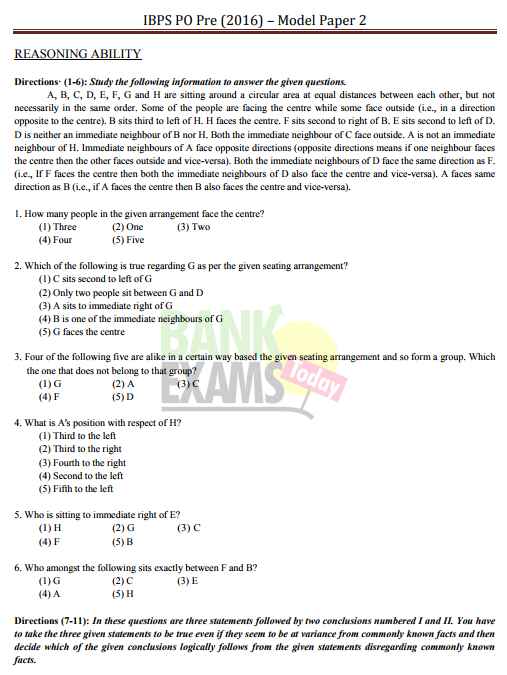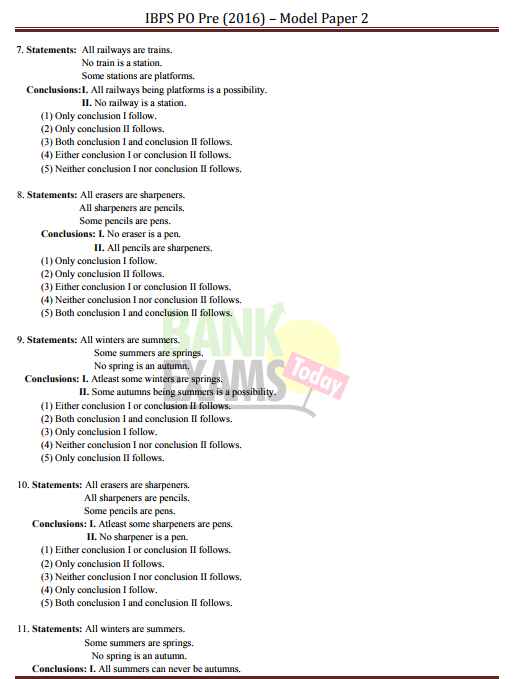|
#2
January 27th, 2018, 03:13 PM
| |||
| |||
| Re: Sample Papers For IBPS PO Exam
As you Asking for the Question Paper of the Reasoning Section of the IBPS PO Examination the Question Paper is given below Reasoning Directions• (1-6): Study the following information to answer the given questions. A, B, C, D, E, F, G and H are sitting around a circular area at equal distances between each other, but not necessarily in the same order. Some of the people are facing the centre while some face outside (i.e., in a direction opposite to the centre). B sits third to left of H. H faces the centre. F sits second to right of B. E sits second to left of D. D is neither an immediate neighbour of B nor H. Both the immediate neighbour of C face outside. A is not an immediate neighbour of H. Immediate neighbours of A face opposite directions (opposite directions means if one neighbour faces the centre then the other faces outside and vice-versa). Both the immediate neighbours of D face the same direction as F. (i.e., If F faces the centre then both the immediate neighbours of D also face the centre and vice-versa). A faces same direction as B (i.e., if A faces the centre then B also faces the centre and vice-versa). 1. How many people in the given arrangement face the centre? (1) Three (2) One (3) Two (4) Four (5) Five 2. Which of the following is true regarding G as per the given seating arrangement? (1) C sits second to left of G (2) Only two people sit between G and D (3) A sits to immediate right of G (4) B is one of the immediate neighbours of G (5) G faces the centre 3. Four of the following five are alike in a certain way based the given seating arrangement and so form a group. Which the one that does not belong to that group? (1) G (2) A (3) C (4) F (5) D 4. What is A's position with respect of H? (1) Third to the left (2) Third to the right (3) Fourth to the right (4) Second to the left (5) Fifth to the left 5. Who is sitting to immediate right of E? (1) H (2) G (3) C (4) F (5) B 6. Who amongst the following sits exactly between F and B? (1) G (2) C (3) E (4) A (5) H Directions (7-11): In these questions are three statements followed by two conclusions numbered I and II. You have to take the three given statements to be true even if they seem to be at variance from commonly known facts and then decide which of the given conclusions logically follows from the given statements disregarding commonly known facts. 7. Statements: All railways are trains. No train is a station. Some stations are platforms. Conclusions:I. All railways being platforms is a possibility. II. No railway is a station. (1) Only conclusion I follow. (2) Only conclusion II follows. (3) Both conclusion I and conclusion II follows. (4) Either conclusion I or conclusion II follows. (5) Neither conclusion I nor conclusion II follows. 8. Statements: All erasers are sharpeners. All sharpeners are pencils. Some pencils are pens. Conclusions: I. No eraser is a pen. II. All pencils are sharpeners. (1) Only conclusion I follow. (2) Only conclusion II follows. (3) Either conclusion I or conclusion II follows. (4) Neither conclusion I nor conclusion II follows. (5) Both conclusion I and conclusion II follows. 9. Statements: All winters are summers. Some summers are springs. No spring is an autumn. Conclusions: I. Atleast some winters are springs. II. Some autumns being summers is a possibility. (1) Either conclusion I or conclusion II follows. (2) Both conclusion I and conclusion II follows. (3) Only conclusion I follow. (4) Neither conclusion I nor conclusion II follows. (5) Only conclusion II follows. 10. Statements: All erasers are sharpeners. All sharpeners are pencils. Some pencils are pens. Conclusions: I. Atleast some sharpeners are pens. II. No sharpener is a pen. (1) Either conclusion I or conclusion II follows. (2) Only conclusion II follows. (3) Neither conclusion I nor conclusion II follows. (4) Only conclusion I follow. (5) Both conclusion I and conclusion II follows. 11. Statements: All winters are summers. Some summers are springs. No spring is an autumn. Conclusions: I. All summers can never be autumns. II. Atleast some summers are winters. (1) Either conclusion I or conclusion II follows. (2) Both conclusion I and conclusion II follows. (3) Neither conclusion I nor conclusion II follows. (4) Only conclusion I follow. (5) Only conclusion II follows. Rest of the Question Paper you may get from the below Attachement that is Free to Download IBPS PO Exam Question Paper Reasoning    |